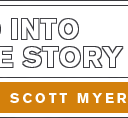Member-only story
Why Your Brain Loves Good Storytelling
Part 4: What Is / What Could Be / What Is / What Could Be / What Is…
In Part 1, we considered a Harvard Business Review article about the influence of stories on the brain, how much of it apparently boils down to the reaction of a chemical called Oxytocin.
In Part 2, we considered additional chemical reactions in the brain related to storytelling: Cortisol during tense moments, Oxytocin which promotes a sense of connection to what is happening in the story, and Dopamine which makes us feel more hopeful and optimistic. So a new way of thinking about Three Act Structure:
Empathy [Oxytocin]: Establish a point of emotional resonance with characters.
Tension [Cortisol]: Create a dilemma that arouses disunity.
Release [Dopamine]: Resolve the dilemma that brings about unity.
In Part 3, we explored another HBR article and came away with three important questions to ask as part of the story-crafting process:
- Who is my audience?
- How can I make the script reader feel like the hero?
- How can I imbue my story with conflict?
Today, we look at yet another Harvard Business Review article: Structure Your Presentation Like a Story.
After studying hundreds of speeches, I’ve found that the most effective presenters use the same techniques as great storytellers: By reminding people of the status quo and then revealing the path to a better way, they set up a conflict that needs to be resolved.
That tension helps them persuade the audience to adopt a new mindset or behave differently — to move from what is to what could be. And by following Aristotle’s three-part story structure (beginning, middle, end), they create a message that’s easy to digest, remember, and retell.
Here is a chart visualizing this idea:

Once again, Three Act Structure. What’s intriguing to me is how similar this looks to a visual tool I use in my own teaching about screenplay structure. Imagine each What Is and What Could Be section as a group of scenes. Now imagine a horizontal line connecting all of the What Is groups of scenes. Let’s call that the Plotline. This is the realm of…

